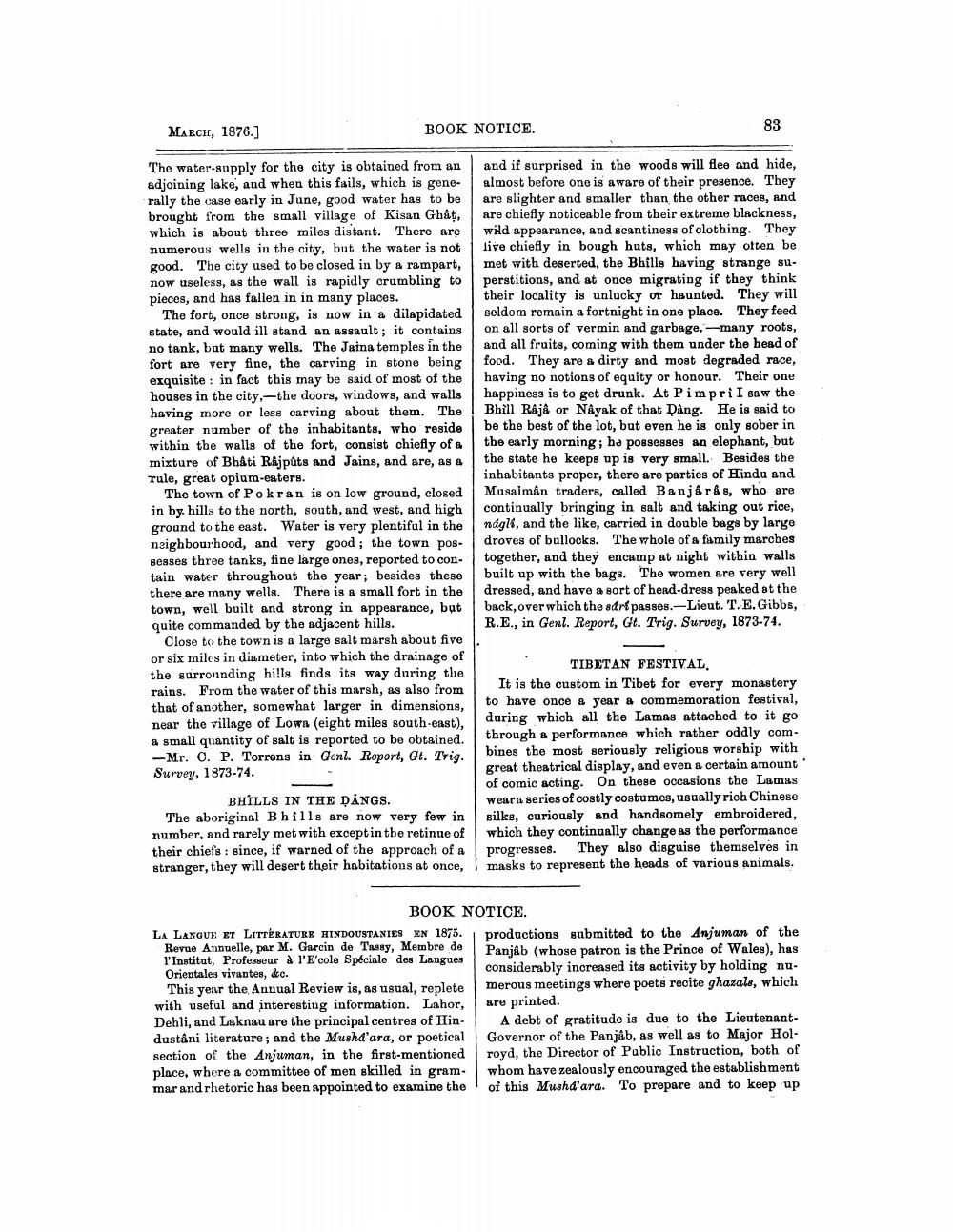________________
MARCH, 1876.]
BOOK NOTICE.
The water-supply for the city is obtained from an adjoining lake, and when this fails, which is generally the case early in June, good water has to be brought from the small village of Kisan Ghât, which is about three miles distant. There are numerous wells in the city, but the water is not good. The city used to be closed in by a rampart, now useless, as the wall is rapidly crumbling to pieces, and has fallen in in many places.
The fort, once strong, is now in a dilapidated state, and would ill stand an assault; it contains no tank, but many wells. The Jaina temples in the fort are very fine, the carving in stone being exquisite: in fact this may be said of most of the houses in the city,-the doors, windows, and walls having more or less carving about them. The greater number of the inhabitants, who reside within the walls of the fort, consist chiefly of a mixture of Bhâti Râjpûts and Jains, and are, as a rule, great opium-eaters.
The town of Pokran is on low ground, closed in by hills to the north, south, and west, and high ground to the east. Water is very plentiful in the neighbourhood, and very good; the town possesses three tanks, fine large ones, reported to contain water throughout the year; besides these there are many wells. There is a small fort in the town, well built and strong in appearance, but quite commanded by the adjacent hills.
Close to the town is a large salt marsh about five or six miles in diameter, into which the drainage of the surrounding hills finds its way during the rains. From the water of this marsh, as also from that of another, somewhat larger in dimensions, near the village of Lowa (eight miles south-east), a small quantity of salt is reported to be obtained. -Mr. C. P. Torrens in Genl. Report, Gt. Trig. Survey, 1873-74.
BHILLS IN THE DANGS. The aboriginal Bhills are now very few in number, and rarely met with except in the retinue of their chiefs: since, if warned of the approach of a stranger, they will desert their habitations at once,
LA LANGUE ET LITTÉRATURE HINDOUSTANIES EN 1875. Revue Annuelle, par M. Garcin de Tassy, Membre de l'Institut, Professeur à l'E'cole Spéciale des Langues Orientales vivantes, &c.
BOOK NOTICE.
This year the Annual Review is, as usual, replete with useful and interesting information. Lahor, Dehli, and Laknau are the principal centres of Hindustâni literature; and the Mushd'ara, or poetical section of the Anjuman, in the first-mentioned place, where a committee of men skilled in grammar and rhetoric has been appointed to examine the
83
and if surprised in the woods will flee and hide, almost before one is aware of their presence. They are slighter and smaller than the other races, and are chiefly noticeable from their extreme blackness, wild appearance, and scantiness of clothing. They live chiefly in bough huts, which may often be met with deserted, the Bhills having strange superstitions, and at once migrating if they think their locality is unlucky or haunted. They will seldom remain a fortnight in one place. They feed on all sorts of vermin and garbage, many roots, and all fruits, coming with them under the head of food. They are a dirty and most degraded race, having no notions of equity or honour. Their one happiness is to get drunk. At Pimpri I saw the Bhill Râja or Nayak of that Dâng. He is said to be the best of the lot, but even he is only sober in the early morning; he possesses an elephant, but the state he keeps up is very small. Besides the inhabitants proper, there are parties of Hindu and Musalman traders, called Banjârâs, who are continually bringing in salt and taking out rice, nágli, and the like, carried in double bags by large droves of bullocks. The whole of a family marches together, and they encamp at night within walls. built up with the bags. The women are very well dressed, and have a sort of head-dress peaked at the back, over which the sart passes.-Lieut. T. E. Gibbs, R.E., in Genl. Report, Gt. Trig. Survey, 1873-74.
TIBETAN FESTIVAL.
It is the custom in Tibet for every monastery to have once a year a commemoration festival, during which all the Lamas attached to it go through a performance which rather oddly combines the most seriously religious worship with great theatrical display, and even a certain amount of comic acting. On these occasions the Lamas weara series of costly costumes, usually rich Chinese silks, curiously and handsomely embroidered, which they continually change as the performance progresses. They also disguise themselves in masks to represent the heads of various animals.
productions submitted to the Anjuman of the Panjab (whose patron is the Prince of Wales), has considerably increased its activity by holding numerous meetings where poets recite ghazals, which are printed.
A debt of gratitude is due to the LieutenantGovernor of the Panjab, as well as to Major Holroyd, the Director of Public Instruction, both of whom have zealously encouraged the establishment of this Mushd'ara. To prepare and to keep up




